Вы здесь
Mounds with "whiskers" in Central Kazakhstan.
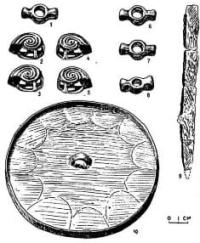
Grave structures in Central Kazakhstan.
"Unique monuments of Kazakhstan - "mounds with "whiskers" - have attracted the attention of scientists for about half a century. In the late 60s, this type of burial structures became the subject of a special study. As a result of archaeological work, M.K. Kadyrbayev found out the purpose of the entire complex of structures and identified four types of mounds "with a mustache". With the expansion of archaeological research, such complexes were discovered outside of Central Kazakhstan, in particular in the Upper Irtysh region. Over a two-hundred-year period of archaeological study in Eastern Kazakhstan, a wide variety of monuments from the Paleolithic era to the Middle Ages have been recorded. However, the mounds now known in science as "mounds with a mustache" were unknown here."
Antiquities of Kazakhstan. "Mounds with "Whiskers" of Eastern Kazakhstan". F.Kh. Arslanova. 1975.
Funeral rites in Central Kazakhstan.
The vast territory of Central Kazakhstan in the Early Iron Age was inhabited by tribes that left behind surprisingly uniform and stable burial structures. In the west and east, north and south of Sary-Arka, in the open steppes, mountain and river valleys, burial mounds with earth and stone embankments are widespread, monumental structures that have received the unfortunate name of "whiskered" burial mounds in scientific literature.
Unlike other monuments in Central Kazakhstan, both types of burial mounds do not form large burial grounds. There are no more than 10 - 15 of them in one burial ground. The ratio of the first and second types of burial mounds in burial grounds can be expressed as one to five or ten, in other words, for each burial ground consisting of 5 - 10 ordinary burial mounds, there is one burial mound with stone ridges.
This proportion is not observed in all areas of Central Kazakhstan. There are more burial grounds with kurgans of the second type in the Ulutau, Shet, Aktogai and Karkaraly districts of the Karaganda (Ulytau - A.P.) region, i.e. in the central regions of the Kazakh low hills.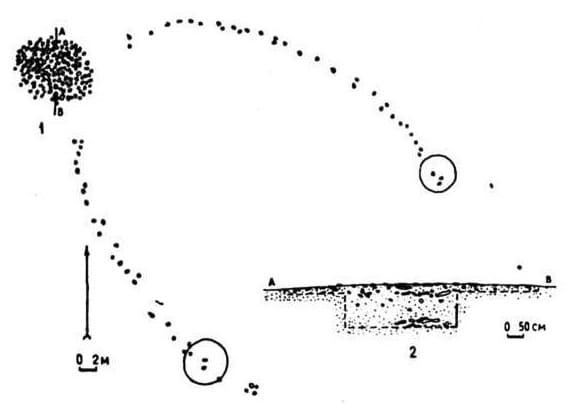
In other, peripheral regions in relation to them, their number gradually decreases. In general, the area of kurgans with stone ridges is quite defined and covers in the west the region of the Ulutau Mountains and the upper reaches of the Ishim River, in the north - the southern regions of the Kokchetav (Akmola - A.P.) region, up to Shchuchinsk and Lake Borovoe, in the east - the zone of flat ridges and low hills of the Pavlodar region, up to the regions of the Chingiz Range and its margins.
The southern border reaches the northern regions of Pribalkhashye and Betpak-Dala. It goes without saying that the territory under consideration is only the area of the greatest concentration of monuments of this type, but the possibility of finding individual burial mounds beyond its borders is not excluded.
For example, a case of the discovery of a similar burial mound in the Volga region is known. Several such burial mounds have also been discovered in Southern Kazakhstan and Semirechye. This very peculiar type of burial structures is one of the main distinguishing features of the Tasmola culture, distinguishing it from other cultures of the Scythian period, both in adjacent and more distant territories.
What is remarkable about it and what are its features? At present, it can be considered proven that the burial mounds "with a mustache" are a complex burial complex of stone structures, found in several versions. It consists of a large main mound and a small mound of low height adjoining it from the eastern side or located at a considerable distance and two stone ridges extending from it to the east, 1.5 - 2 meters wide and 20 to 200 meters or more long.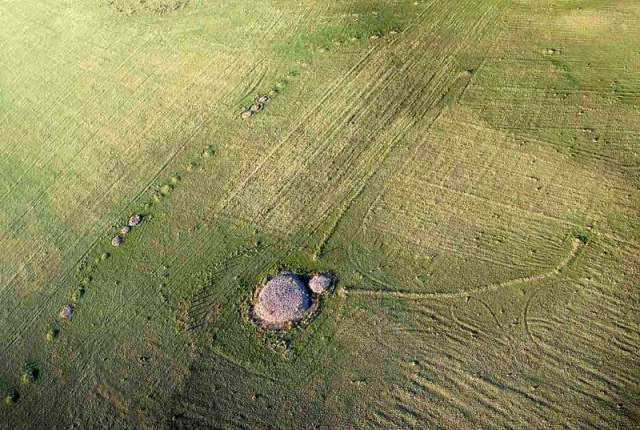
The stone ridges have the shape of semi-arcs and are often limited at the beginning and end by round stone structures of the kurgan type. Thus, the concept of a kurgan "with a mustache" includes three components, or elements of artificial structures: a large kurgan with a human burial, a small one with a horse burial and a clay vessel, and stone ridges.
Consideration of any component separately ultimately leads to an incorrect understanding of the entire complex as a whole. This is the main mistake of researchers who defined kurgans "with a mustache" as monuments of only ritual purpose.
The main kurgan contains a burial, which is accompanied, if it is not plundered, by a large number of various inventory. The small kurgan does not have a burial pit. Under its embankment, in the center, at the level of the buried soil, a horse skeleton or its individual bones (skull, leg bones) are usually found, and in the eastern part - one, less often - two clay vessels.
The described type of mound "with a mustache" is the most common, but there are also other variants. One of them is double mounds, when the small mound is located not on the eastern, but on the southern side of the large mound. In this case, they are usually of the same size.
Such a layout of the monument is known from the excavations of B. N. Zhdanov. Mounds of a similar layout were studied by us in 1957, 1958 and 1962 in the Egiz-Koytas, Koktal and Karamurun tracts. Another option should be considered a combined type of mounds "with a mustache", which has two varieties: a small one is built on top of a large one, and two mounds merge under one embankment.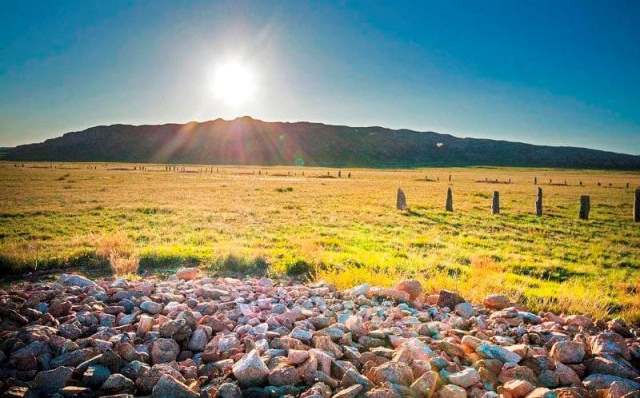
It should be especially noted that regardless of the layout options, any of them consists of the same elements that are present in the main type: a mound containing a human burial, a mound containing a horse burial or individual bones, a clay vessel, and stone ridges (mustache), necessarily stretching in an eastern direction. In double mounds, the burial was usually in the northern mound, and in the southern one there were separate parts of a horse skeleton and a clay vessel.
A single case of the construction of a small mound on top of a large one was recorded in the Karabiye valley.
It is very interesting that even such a structural change did not affect the burial ritual. Under the embankment of the small mound, despite the unusual location, a crushed clay vessel was found. Another variation of this variant should be considered mound 19 from the Tasmola burial ground.
It did not have an eastern (small) mound, the functions of which were performed by the main mound. Under its embankment, on the eastern side, on the ancient surface lay fragments of two clay vessels, and in the central part there was a burial chamber.
A mound of a similar layout, but of a much later time, is also known from the Kanattas valley. In general, the accumulated material quite convincingly characterizes the features of the burial rite of the ancient tribes of Central Kazakhstan. The "whiskered" mound should be considered as a single complex consisting of the main burial in a large mound and related ritual structures.
However, if the simultaneity of these structures with the burial is not in doubt, then the design features of the stone ridges still remain a mystery to some extent. M. P. Gryaznov suggested that these are the remains of low walls with tower-and-pillar structures at the ends.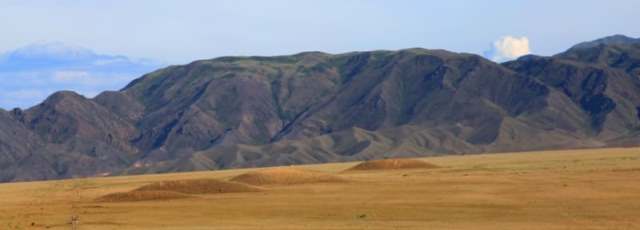
In the summer of 1958, the author specifically studied the stone ridges of three "whiskered" mounds in the Sangru tract, but their poor preservation did not allow him to capture in detail the shape and order of the structure. It was only noted that the stone ridges are not pavements or paths made of flat stones, but consist of individual links forming a ridge several tens of meters long and 1.5 - 2 meters wide.
Between these links, massive stone slabs were sometimes dug vertically (Karabie I). Each such link was limited on the long sides by rows of stone slabs dug to a depth of 10 - 15 cm, and the one and a half meter gap between them was filled with shapeless stone fragments.
Having compared the number of stones with the length and width of the ridges (60-80 small stone fragments per section 5 meters long and 2 meters wide), we obtained on average two rows of stones 20 - 30 cm high. A. M. Orazbaev discovered a completely different design of stone ridges in 1961.
On the section of the ridge with a round end that he studied, there were two rows of stone slabs, partitioned transversely by end slabs. The ridge ended with a structure in the form of a round fence made of flat-laid slabs. Two years later, I studied another stone ridge in the Danybai tract.
The uncovered ridge, 20 meters long, consisted of 15 adjacent rings of large stones laid flat. The entire area of the rings was filled with stones, so that the ridge seemed to consist of a chain of small mounds, closed together. The diameter of the largest ring, which ended the eastern part of the ridge, was 2.5 meters, all the other rings had a diameter of 1.5 - 2 meters.
Since these reconstructions are based on isolated facts, no generalizations should be made yet, although it is already certain that the stone ridges (whiskers) are, to some extent, architectural structures, not built everywhere the same way, as two examples have shown.
The burial pits, which were arranged, as already mentioned, under the embankment of the large, or main, mound, had an oval shape, their maximum size was 2 x 1 meters with a depth of up to 2 meters. They were always covered from above with massive stone slabs. In the pits there were single burials, on the back, in an extended position.
The second type of burial structures is represented by ordinary burial mounds with stone, mixed and earthen embankments. Under the embankment there were rings of large fragments of wild stone, and their bases were surrounded by ditches.
Ditches are usually found near burial mounds with an embankment of earth or earth and rubble. Stone rings are found under earthen, mixed and stone embankments, although in the latter case they are not always easy to detect. Ditches and stone rings have not been found near all burial mounds.
The same burial rite can be traced in both main types of burial mound structures. The burial mounds of both the first and second types usually contain a single burial in an oval-shaped pit made of earth, covered from above with stone slabs. Those buried in the second type of burial mounds are recorded in the same position and have the same orientation as in the first type of monuments.
It should be noted that the burial structures are extremely stable and the burial rites are constant, existing with minor changes from the VIIth to the IIIrd centuries BC. Some burials in the Tasmola I, V and VI burial grounds, which, as we will see later, date back to the VIIth - VIth centuries BC, are somewhat different, in addition to the inventory.
In these mounds, the pits were dug in such a way that a third of its area would remain free after the burial of a person. These are, in general terms, the features of the burial structures of the Tasmola culture of Central Kazakhstan.
Authority:
"Ancient Culture of Central Kazakhstan". D. Kh. Margulan. K. A. Akishev, M. K. Kadyrbayev, A. Morazbayev. 1966.
Photos by:
https://ru.35photo.pro/photo_1324777/#author/1324777







